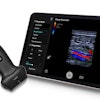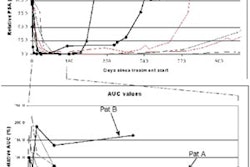(Ultrasound Review) In a recent American Journal of Roentgenology study of soft-tissue tumors in infancy, high-frequency grayscale and color Doppler imaging were used to evaluate distinguishing features.
"Birthmarks of various shades of red, blue, of pink represent vascular tumors or malformations, and a distinction between them is based on the detection of cellular proliferation in tumors and its absence in malformations," reported radiologists and dermatologists at the University of Montreal in Quebec, Canada. Technical advancements in image quality and vascular sensitivity have enabled sonography to be used to evaluate the subcutaneous portion of these lesions more accurately.
The group studied 16 children with vascular tumors, excluding hemangiomas, which were scheduled for biopsy diagnosis. The ultrasound characteristics evaluated included margin definition, echogenicity, number of blood vessels, resistive index, and peak systolic velocity. The ultrasound characteristics were compared with the biopsy findings.
There were five hemangioendotheliomas, six tufted angiomas, and five infantile myofibromatoses. Tufted angiomas were echogenic, while infantile myofibromatoses were isoechoic or hypoechoic. None of the tufted angiomas or infantile myofibromatoses had calcifications, but four of five hemangioendotheliomas had calcifications. Hemangioendotheliomas and tufted angiomas were ill-defined lesions, while in contrast infantile myofibromatoses that were well defined, they reported.
Comparing vascularity, tufted angiomas and infantile myofibromatoses were the least vascularized of the three tumor types, with low velocity flow and low vessel density. In most cases of hemangioendotheliomas, the vessel density was estimated as medium and the peak systolic frequency shift was greater than 2k Hz. A previous study by the same authors demonstrated that hemangiomas could be differentiated from other masses by evaluating vascular characteristics with ultrasound. Hemangiomas have a high vessel density (>five vessels/cm2), and peak systolic Doppler shift greater than 2k Hz, they found.
The authors concluded that "the vascular tumors -- hemangioendotheliomas, tufted angiomas, and infantile myofibromatoses -- were distinguishable from hemangiomas on Doppler sonography in all cases except one hemangioendothelioma. Unlike hemangiomas, these lesions should be investigated by biopsy or excision."
Vascular soft-tissue tumors in infancy: distinguishing features on Doppler sonographyJ Dubois et al
Department of medical imaging, Hôpital Sainte-Justine and University of Montreal, Montreal, Quebec, Canada
AJR 2002 June; 178:1541-1545
By Ultrasound Review
July 24, 2002
Copyright © 2002 AuntMinnie.com



















